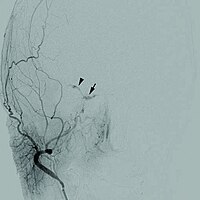
Photo from wikipedia
Alzheimer's disease (AD) is associated with reduction of regional cerebral blood flow (rCBF) in various brain regions. Although nicergoline has been used to treat cognitive impairment in various types of… Click to show full abstract
Alzheimer's disease (AD) is associated with reduction of regional cerebral blood flow (rCBF) in various brain regions. Although nicergoline has been used to treat cognitive impairment in various types of dementia, the effect of nicergoline on brain perfusion in AD has not been elucidated. The aim of the study was to examine the effect of nicergoline on rCBF in patients with early AD using technetium‐99m hexamethylpropylene amine oxime single‐photon emission computed tomography (SPECT). For 1.7 years on average, 22 patients with early AD received nicergoline (30 mg twice daily) and acetylcholinesterase inhibitors (AChEI), whereas other 22 patients received AChEI only. All patients underwent assessment of dementia severity and SPECT scans at baseline and follow‐up. We compared baseline rCBF and annual percent change of rCBF between the two groups. There were no significant differences in rCBF between the groups at baseline. Although changes in dementia severity was not statistically different, the annual percent changes of rCBF were higher in the left temporal pole (−0.12 ± 3.95 vs −3.38 ± 3.30, P = 0.002) and middle cingulate gyrus (1.91 ± 3.58 vs −1.34 ± 3.17, P = 0.002) among the nicergoline group. Our study demonstrated that nicergoline treatment combined with AChEI either better preserves or further improves cerebral perfusion in the temporal and cingulate cortices in patients with early AD compared to AChEI treatment alone. These results may indicate potential beneficial effects of nicergoline on brain functions in AD.
Journal Title: International Journal of Imaging Systems and Technology
Year Published: 2019
Link to full text (if available)
Share on Social Media: Sign Up to like & get
recommendations!